Dental Implants Problems include failing implants, loose implant crowns and dental implants infection. Treatment of these complications and problems with dental implants was performed in our dental implants office. Particularly our office has 16 cosmetic dentists, specialists (including two oral surgeons) and lab ceramists in one high-end midtown Manhattan location. People seeking our Dental Implants team for more complex care also have access to our affiliated team of 12 medical doctors in our building.
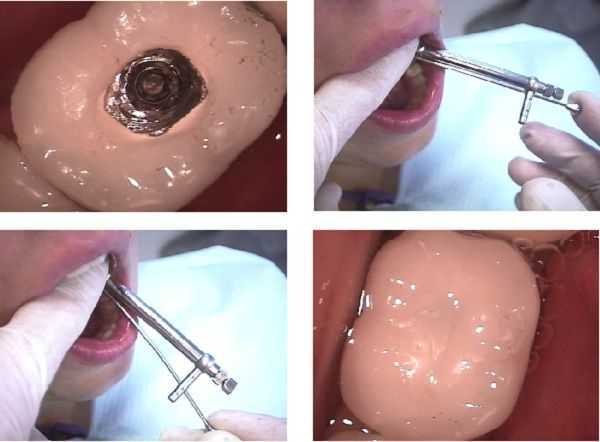
Dental Implants Problems with a Loose Crown
This patient presented with a loose crown on top of a dental implant. The x-ray appeared to show intact bone around the implant and it also showed the mesio-distal location of the implant abutment within the crown.
A conservative occlusal preparation was made in the porcelain crown with a round diamond bur. Then a sharp-edged steel bur was used to cut through the metal of the crown underneath the porcelain. Cutting through the metal of the crown was performed carefully so as not to damage the second stage implant abutment while looking for the second stage abutment screw.
The inner metal of the crown was smoothed once the screw was seen. This was done to allow enough room for an implant screwdriver that would fit the brand of implant screw. A torque driver was then connected to the implant screwdriver and the implant company’s recommended torque applied. Blue wax was then placed over the screw and composite resin dental bonding of the appropriate shade was placed in the occlusal opening. This is among the most common dental implants problem. It can lead to screw fracture that is far more complex of a problem if left untreated.
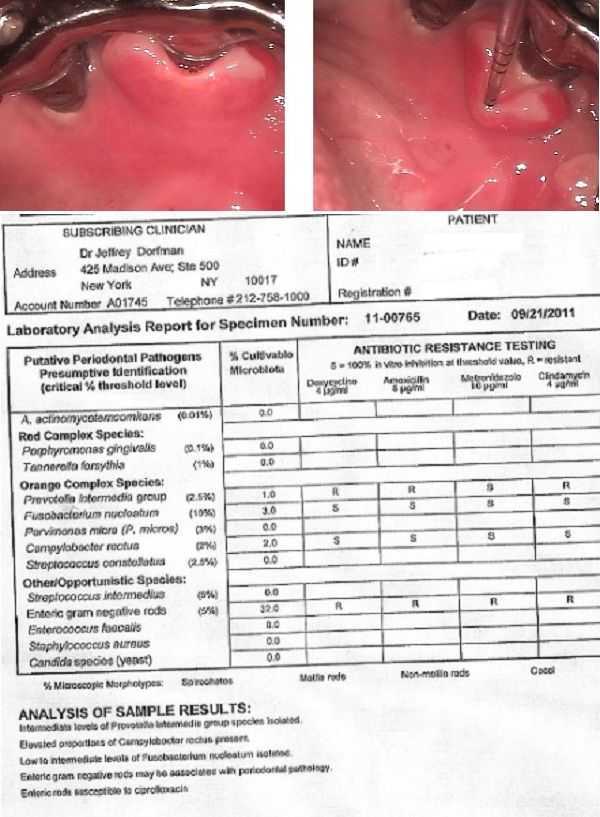
Dental Implants Infection
In brief there was a gum infection around twenty year old dental implants in a patient who had not visited a dentist for over 6 years. In this case the clasp of the dental implant denture had also broken. This caused the denture to rub against the dental implants and gums in the presence of calculus (white, hardened plaque). These images were taken after Antibiotic & Initial Periodontal Therapy were completed.
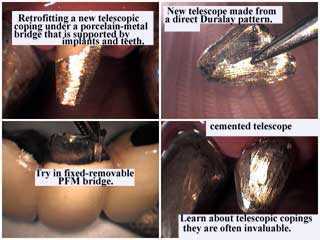
Dental Implants Problems Requiring a Telescoping Crown
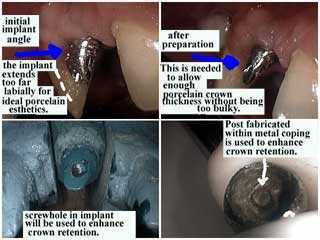
Dental Implants Extend Too Far Out of the Mouth

Dental Implants Problems Related to Treatment Sequencing
Second stage dental implant oral surgery. Uncovering the first stage implant abutments. The text in the image says: Second stage implant surgery. Uncovering abutments. #8 and #9 implants shown. #6 and #11 implants will also be uncovered. Note that the teeth #’s 7 and 10 were left in the otherwise edentulous maxilla to help retain a temporary prosthesis while four implants healed. These teeth will now be extracted, and implants placed and allowed to heal. A new temp is made. This sequence always kept the patient with a fixed temporary.
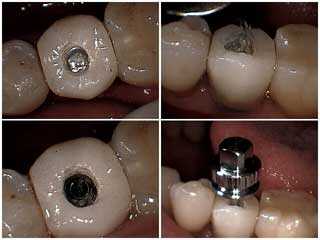
Dental Implants Problems with a Loose Crown
Tightening a loose second stage dental implant screw through a dental crown cemented on a single tooth implant. The crown was loose but the implant itself was loose. You need to differentiate this in advance. Use copious water irrigation with an air-water syringe in addition to handpiece water.
1) Prepare – drill – through occlusal surface of the porcelain into metal substructure of the dental crown. 2) Prep through metal to expose the tiny cotton pellet – we use blue wax – which overlays the slot in the second stage screw. (Place the blue wax before dental crown cementation to prevent the dental cement from filling the dental implant second stage screw slot which would prevent being able to ever turn the screw again). 3) Access through porcelain crown shows second stage screw. 4) The dental implant screwdriver is in place tightening the screw. Close this access opening with blue wax and then composite resin tooth bonding in the occlusal surface.
The size and brand of the dental implant should be discovered
Dentists should consider designing dental crowns for single tooth dental implants with the access already prepared directly to the second stage screw. This would make getting to the screw much easier should the need arise. In addition dentists may need to identify the brand of dental implant so they will have the correct size screwdriver. This should be considered before the procedure begins. The specific brand and size of dental implant may be discovered in several ways. Dental x-rays may help identify the implant. Incidentally sometimes the patient will have this information or if not they may call their prior dentist.
Always Torque to Second Stage Screw to Specification
When placing second stage dental implants ALWAYS torque the second stage screw to the manufacturer’s specification using the manufacturer’s torque driver. This will help avoid the dental implants complications problems discussed here.
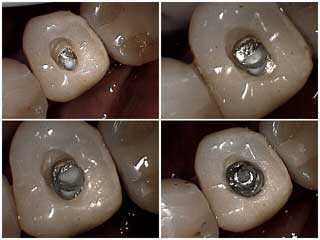
Dental Implants Problems How to Gain Access to a Loose Dental Implant Crown
Gain access to a loose second stage dental implant second stage screw through a dental crown cemented on a single tooth implant. The dental crown was loose but the implant itself was solid. You need to differentiate this in advance. Use copious water irrigation with an air-water syringe in addition to handpiece water. 1) Drill through the occlusal porcelain into metal. 2) and 3) Prepare through the metal to expose the thin dental cement layer between crown and dental implant abutment. 4) Access through the dental crown shows second stage screw covered by cotton pellet.
We prefer to cover this screw instead with blue wax since a cotton pellet will absorb saliva over time but the wax will not. Close this access opening with blue wax and then tooth bonding in the occlusal surface. You could consider designing dental crowns for single tooth implants with the access already prepared directly over the second stage screw. This would make getting to the screw much easier should the need arise.
The size and brand of the dental implant should be discovered
Dentists may need to identify the brand of dental implant so they will have the correct size screwdriver. This should be considered before the procedure begins. The specific brand and size of dental implant may be discovered in several ways. Dental x-rays may help identify the implant. Incidentally sometimes the patient will have this information or if not they may call their prior dentist.
Always Torque to Second Stage Screw to Specification
When placing second stage dental implants ALWAYS torque the second stage screw to the manufacturer’s specification using the manufacturer’s torque driver.
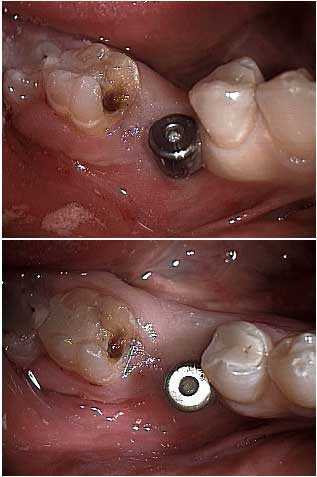
Dental Implants Problems Include Poor Placement
Where not to place dental implants. The surgical placement of a dental implant depends on the quantity and quality of the local bone. The location of this tooth implant rendered it non-restorable. It was removed and a three-unit porcelain metal dental bridge was placed.
To help avoid a dental implants problem consider using a surgical stent to see if the pre-operative available bone will allow a reasonable cosmetic result when the dental crown is placed.

Dental Implants Problems Related to Acrylic Failure in a Dental Implants Bridge
Acrylic failure in an acrylic fused to metal full arch dental implant bridge prosthesis. Before and after pictures of repair to an eight year old fixed removable dental implant bridge. 1) The acrylic separated from the metal of this eight-year-old dental implant prosthesis. 2) The dental implant abutments are shown following removal of the prosthesis. 3) The implant prosthesis showing the separation. 4) Following fabrication of new acrylic to the frame.
The ability to remove, repair and replace a dental implant denture hybrid prosthesis is a good thing. A dental implants problem is usually much easier to resolve with fixed removable prostheses.

Dental Implants Problems Related to Dental Implants Infection and Oral Microbiology
An oral microbiology culture taken from a draining fistula – gum boil – around a maxillary unilateral subperiosteal dental implant. Bacterial cultures should be taken before prescribing antibiotics. This infection was resistant to Penicillin, Tetracycline and Metronidazole. This dental implant infection was successfully treated. The patient successfully maintained these dental implants for 20 years until her death at age 86 in 2009.
This was a particularly complex dental implants problem. Review the Microbiology section here in our website to learn more about how to apply these concepts to complications problems with dental implants.